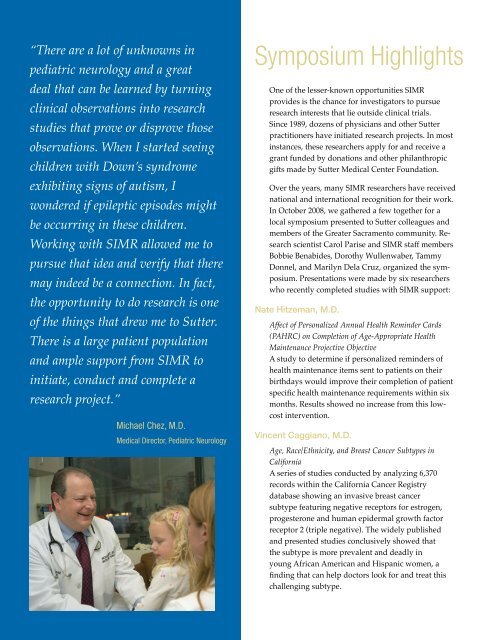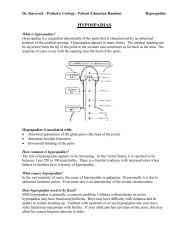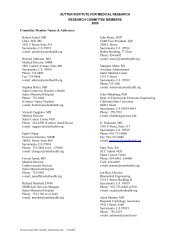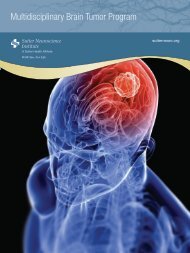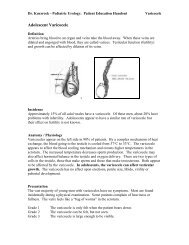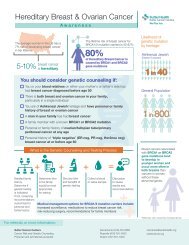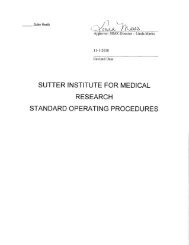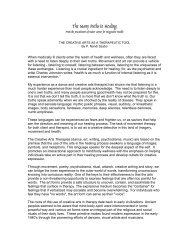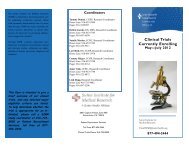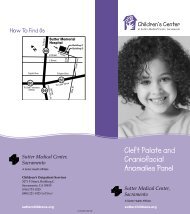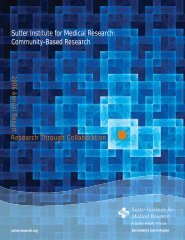Sutter Institute for Medical Research 2008 Annual Report
Sutter Institute for Medical Research 2008 Annual Report
Sutter Institute for Medical Research 2008 Annual Report
Create successful ePaper yourself
Turn your PDF publications into a flip-book with our unique Google optimized e-Paper software.
“There are a lot of unknowns in<br />
pediatric neurology and a great<br />
deal that can be learned by turning<br />
clinical observations into research<br />
studies that prove or disprove those<br />
observations. When I started seeing<br />
children with Down’s syndrome<br />
exhibiting signs of autism, I<br />
wondered if epileptic episodes might<br />
be occurring in these children.<br />
Working with SIMR allowed me to<br />
pursue that idea and verify that there<br />
may indeed be a connection. In fact,<br />
the opportunity to do research is one<br />
of the things that drew me to <strong>Sutter</strong>.<br />
There is a large patient population<br />
and ample support from SIMR to<br />
initiate, conduct and complete a<br />
research project.”<br />
Michael Chez, M.D.<br />
<strong>Medical</strong> Director, Pediatric Neurology<br />
Symposium Highlights<br />
One of the lesser-known opportunities SIMR<br />
provides is the chance <strong>for</strong> investigators to pursue<br />
research interests that lie outside clinical trials.<br />
Since 1989, dozens of physicians and other <strong>Sutter</strong><br />
practitioners have initiated research projects. In most<br />
instances, these researchers apply <strong>for</strong> and receive a<br />
grant funded by donations and other philanthropic<br />
gifts made by <strong>Sutter</strong> <strong>Medical</strong> Center Foundation.<br />
Over the years, many SIMR researchers have received<br />
national and international recognition <strong>for</strong> their work.<br />
In October <strong>2008</strong>, we gathered a few together <strong>for</strong> a<br />
local symposium presented to <strong>Sutter</strong> colleagues and<br />
members of the Greater Sacramento community. <strong>Research</strong><br />
scientist Carol Parise and SIMR staff members<br />
Bobbie Benabides, Dorothy Wullenwaber, Tammy<br />
Donnel, and Marilyn Dela Cruz, organized the symposium.<br />
Presentations were made by six researchers<br />
who recently completed studies with SIMR support:<br />
Nate Hitzeman, M.D.<br />
Affect of Personalized <strong>Annual</strong> Health Reminder Cards<br />
(PAHRC) on Completion of Age-Appropriate Health<br />
Maintenance Projective Objective<br />
A study to determine if personalized reminders of<br />
health maintenance items sent to patients on their<br />
birthdays would improve their completion of patient<br />
specific health maintenance requirements within six<br />
months. Results showed no increase from this lowcost<br />
intervention.<br />
Vincent Caggiano, M.D.<br />
Age, Race/Ethnicity, and Breast Cancer Subtypes in<br />
Cali<strong>for</strong>nia<br />
A series of studies conducted by analyzing 6,370<br />
records within the Cali<strong>for</strong>nia Cancer Registry<br />
database showing an invasive breast cancer<br />
subtype featuring negative receptors <strong>for</strong> estrogen,<br />
progesterone and human epidermal growth factor<br />
receptor 2 (triple negative). The widely published<br />
and presented studies conclusively showed that<br />
the subtype is more prevalent and deadly in<br />
young African American and Hispanic women, a<br />
finding that can help doctors look <strong>for</strong> and treat this<br />
challenging subtype.


